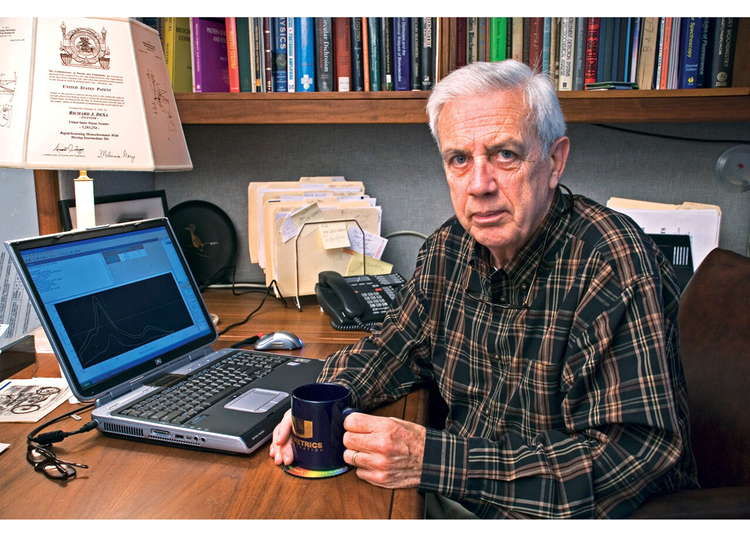The smart Trick of Circular Dichroism That Nobody is Talking About
Wiki Article
Little Known Facts About Uv/vis.
Table of ContentsAbout SpectrophotometersTop Guidelines Of Circularly Polarized LuminescenceExcitement About Uv/vis/nirAll About Circularly Polarized LuminescenceUv/vis Things To Know Before You Get This

Spectrophotometry is most commonly applied to ultraviolet, noticeable, and infrared radiation, modern spectrophotometers can interrogate wide swaths of the electro-magnetic spectrum, including x-ray, ultraviolet, noticeable, infrared, and/or microwave wavelengths. Spectrophotometry is a tool that depends upon the quantitative analysis of particles depending on how much light is taken in by colored compounds.
5 Easy Facts About Spectrophotometers Explained
A spectrophotometer is typically used for the measurement of transmittance or reflectance of services, transparent or opaque solids, such as refined glass, or gases. Although many biochemicals are colored, as in, they absorb noticeable light and therefore can be measured by colorimetric treatments, even colorless biochemicals can frequently be converted to colored compounds suitable for chromogenic color-forming responses to yield compounds appropriate for colorimetric analysis.: 65 However, they can also be developed to determine the diffusivity on any of the listed light ranges that typically cover around 2002500 nm utilizing various controls and calibrations.An example of an experiment in which spectrophotometry is utilized is the determination of the balance constant of a service. A particular chain reaction within a solution might happen in a forward and reverse direction, where reactants form products and products break down into reactants. At some point, this chemical response will reach a point of balance called an equilibrium point.
Everything about Uv/vis
The quantity of light that goes through the solution is a sign of the concentration of specific chemicals that do not allow light to go through. The absorption of light is because of the interaction of light with the electronic and vibrational modes of molecules. Each kind of molecule has an individual set of energy levels related to the makeup of its chemical bonds and nuclei and therefore will absorb light of specific wavelengths, or energies, leading to unique spectral homes.
They are commonly used in numerous markets including semiconductors, laser and optical manufacturing, printing and forensic assessment, as well as in laboratories for the study of chemical substances. Spectrophotometry is typically used in measurements of enzyme activities, determinations of protein concentrations, decisions of enzymatic kinetic constants, and measurements of ligand binding reactions.: 65 Eventually, a spectrophotometer is able to figure out, depending on the control or calibration, what substances are present in a target and exactly how much through calculations of observed wavelengths.
This would come as a service to the previously produced spectrophotometers which were unable to absorb the ultraviolet properly.
Circularly Polarized Luminescence Can Be Fun For Everyone
It would be discovered that this did not offer satisfying outcomes, therefore in Model B, there was a shift from a glass to a quartz prism which permitted better absorbance outcomes - UV/Vis/NIR (https://padlet.com/julieanndesalorenz30606/olis-clarity-srqqvp7768okh664). From there, Design C was born with a change to the wavelength resolution which wound up having 3 systems of it producedIt irradiates the sample with polychromatic light which the sample soaks up depending upon its properties. It is sent back by grating the photodiode selection which detects the wavelength area of the spectrum. Ever since, the production and execution of spectrophotometry devices has actually increased tremendously and has become one of the most innovative instruments of our time.

Uv/vis Can Be Fun For Everyone
Historically, spectrophotometers utilize a monochromator containing a diffraction grating to produce the analytical spectrum. The grating can either be movable or repaired. If a single detector, such as a photomultiplier tube or photodiode is utilized, the grating can view it be scanned step-by-step (scanning spectrophotometer) so that the detector can determine the light strength at each wavelength (which will correspond to each "action").In such systems, the grating is fixed and the intensity of each wavelength of light is determined by a various detector in the array. When making transmission measurements, the spectrophotometer quantitatively compares the fraction of light that passes through a referral service and a test solution, then digitally compares the intensities of the 2 signals and calculates the portion of transmission of the sample compared to the recommendation requirement.

Report this wiki page